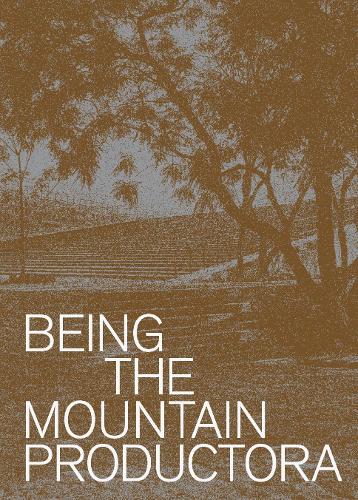
Being the Mountain: Productora
(Hardback)
Publishing Details
Being the Mountain: Productora
By (Author) Carlos Bedoya
By (author) Wonne Ickx
By (author) Victor Jaime
By (author) Abel Perles
By (author) Jesus Vassallo
Actar Publishers
Actar Publishers
20th October 2020
United States
Classifications
General
Non Fiction
History of architecture
Landscape architecture and design
724.6
Physical Properties
Hardback
96
Width 170mm, Height 241mm, Spine 3mm
363g
Description
The publication casts new light on the relationship between modernism and the ground, calling into question received assumptions and liberating new possibilities for how a building relates to its site.
The result of research PRODUCTORA initiated as winners of the Mies Crown Hall Americas Prize for Emerging Practice at Illinois Institute of Technology, Being the Mountain examines the relationship between architecture and the ground it occupies, an interaction so obviousa building must touch the groundthat it often remains underexplored. Richly illustrated contributions by Carlos Bedoya, Frank Escher, Wonne Ickx, Vronique Patteeuw, and Jess Vassallo revisit significant moments in architectural history that cast new light on the techniques and legacies of modernism, especially in settings like Mexico and California, where architects such as Ricardo Legorreta and John Lautner incorporated dramatic natural topography in their agendas. Additional essays investigate the role of the ground in the thought of Kenneth Frampton in the 1980s and Luis Moreno Mansilla in the 1990s, as well as point to important parallels between premodern land practices, twentieth-century art, and todays architecture.
Together, these episodes call into question our received assumptions and present new possibilities for the connection between a building and its site. A portfolio of related projects by PRODUCTORA concludes the book, further drawing out the idea of architecture as a form of constructed ground.
PRODUCTORA is a Mexico Citybased architectural studio founded in 2006 by Carlos Bedoya (1973, Mexico), Wonne Ickx (1974, Belgium), Victor Jaime (1978, Mexico), and Abel Perles (1972, Argentina). The studios work is distinguished by an interest in precise geometries, the production of clearly legible projects with limited gestures, and the search for timeless buildings.
PRODUCTORA has been recognized by the Architectural League of New York with the Young Architects Forum (2007) and Emerging Voices (2013) awards. In 2016, they received the Mies Crown Hall Americas Prize for Emerging Practice from Illinois Institute of Technology in Chicago for the Pavilion on the Zocalo. In 2018, PRODUCTORA was recognized with the Oscar Niemeyer Award for Latin American Architecture for the Teopanzolco Cultural Center, a project realized in collaboration with Isaac Broid. That same project also received the Simon Architecture Prize - Living Places in Barcelona, a recognition organized in collaboration with the Fundaci Mies van der Rohe that celebrates collective places in which public and community life develops.
The partners of PRODUCTORA have taught at local institutions such as the Universidad Iberoamericana, the Centro de Diseo, TEC de Monterrey, and the Universidad La Salle in Mexico City as well as international universities such as the University of California, Los Angeles, Illinois Institute of Technology, and Harvard Universitys Graduate School of Design. In 2011, PRODUCTORA founded, alongside curator and art critic Ruth Estvez, LIGA - Space for Architecture - Mexico City, a platform that promotes emerging Latin American architecture through exhibitions, conferences, and workshops.
Published by the Illinois Institute of Technology College of Architecture & Actar Publishers
Reviews
"A product of studios that PRODUCTORA's four partners (Carlos Bedoya, Wonne Ickx, Victor Jaime, Abel Perles) conducted at IIT after winning MCHAP.emerge, the book features a half-dozen essays followed by a presentation of a decade of the firm's work through images. In the former, Ickx explores some of Ricardo Legorreta's buildings, most notably the mountain-like Hotel Las Brisas Ixtapa (seeing the building here reminds me how close I came to including it in my 100 Years, 100 Buildings for 1981), and later in the book he dives into Luis Barragan's Jardines del Pedregal and Francisco Artigras's striking Casa del Risco (fourth spread below) in the same development. Bedoya looks at art and architecture -- both vernacular and capital-A architecture -- that carves into the earth. External contributions are found in Veronique Patteeuw's essay on "Kenneth Frampton's interest in the ground," Frank Escher discusses modern houses in California that creatively incorporate the rocky landscapes they sit upon (second spread), and Jesus Vassallo writes about the "geologic gestures" in the work of Luis Moreno Mansilla and others (third spread)." --John Hill, A Daily Dose of Architecture
